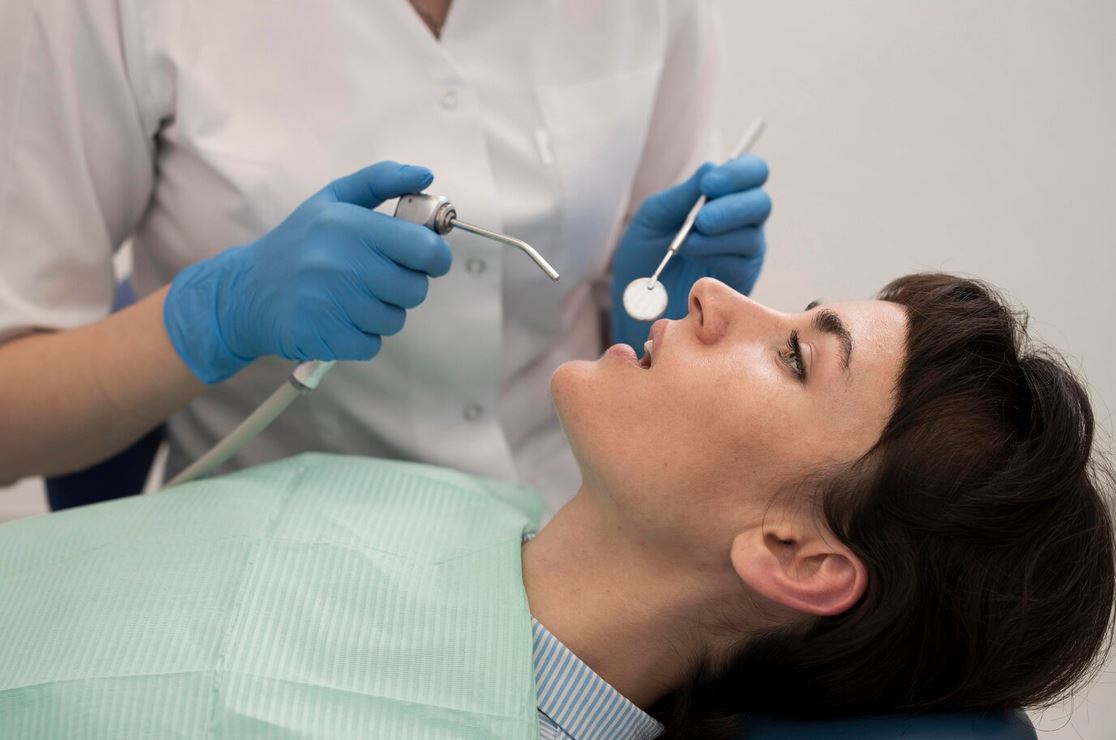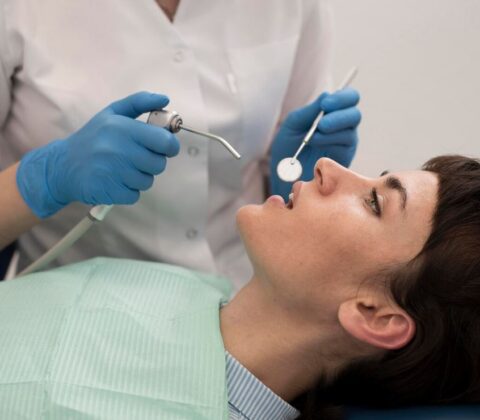

Straighten Up: The Benefits of Early Orthodontic Intervention

Early orthodontic intervention refers to the practice of addressing orthodontic issues in children and teenagers at an early age. This typically involves the use of braces or other orthodontic appliances to correct misaligned teeth, bite problems, and other dental issues. The goal of early intervention is to guide the growth and development of the teeth and jaws, ensuring proper alignment and function.
Addressing orthodontic issues early on is crucial because the jaw and teeth are still growing and developing during childhood and adolescence. By intervening at this stage, orthodontists can take advantage of the natural growth processes to achieve optimal results. Early intervention can help prevent more serious dental problems in the future and can often reduce the need for more extensive treatment later on.
Understanding the Importance of Straight Teeth
Aesthetics and self-confidence: One of the most obvious benefits of straight teeth is improved aesthetics. A straight smile can greatly enhance a person’s appearance and boost their self-confidence. When people feel good about their smile, they are more likely to smile more often, which can have a positive impact on their overall well-being.
Improved oral hygiene: Straight teeth are easier to clean and maintain compared to crooked or crowded teeth. Misaligned teeth can create tight spaces where plaque and food particles can get trapped, increasing the risk of tooth decay and gum disease. With straight teeth, it is easier to brush and floss effectively, leading to better oral hygiene and a reduced risk of dental problems.
Reduced risk of dental problems: Crooked or misaligned teeth can lead to a variety of dental problems, including tooth decay, gum disease, and even jaw joint disorders. When the teeth are properly aligned, they distribute biting forces evenly, reducing the risk of excessive wear or damage to the teeth. Additionally, proper alignment can help alleviate strain on the jaw joints, reducing the risk of temporomandibular joint (TMJ) disorders.
The Role of Orthodontic Treatment in Oral Health
Correcting bite issues: Bite problems, such as overbite, underbite, or crossbite, can affect the way the teeth come together when biting or chewing. These issues can lead to uneven wear on the teeth, jaw pain, and difficulty in speaking or eating. Orthodontic treatment can help correct these bite problems, improving overall oral health and function.
Aligning teeth for better function: Misaligned teeth can interfere with proper chewing and speaking. When the teeth are not aligned correctly, it can be challenging to bite into and chew food effectively. This can lead to digestive issues and poor nutrition. Orthodontic treatment can align the teeth properly, allowing for better function and improved overall health.
Preventing tooth decay and gum disease: Crooked or crowded teeth can make it difficult to clean between the teeth and along the gumline. This can result in plaque buildup, which can lead to tooth decay and gum disease. By straightening the teeth, orthodontic treatment makes it easier to maintain good oral hygiene and reduces the risk of these dental problems.
Benefits of Early Orthodontic Intervention for Children
Improved facial development: Early orthodontic intervention can help guide the growth of the jaws and facial bones in children. By addressing issues such as narrow dental arches or excessive overbite at a young age, orthodontists can promote proper facial development and prevent more severe problems in the future.
Reduced risk of future dental problems: By addressing orthodontic issues early on, children are less likely to experience more serious dental problems later in life. For example, correcting a crossbite early can prevent uneven wear on the teeth and reduce the risk of jaw joint disorders. Early intervention sets a solid foundation for long-term oral health.
Shorter treatment time: In some cases, early orthodontic intervention can help reduce the overall treatment time needed. By addressing orthodontic issues at a younger age, orthodontists can take advantage of the natural growth and development processes to achieve optimal results more efficiently. This can mean less time spent wearing braces or other orthodontic appliances.
The Advantages of Early Orthodontic Treatment for Teens
Improved self-esteem: Teenagers often face social pressures and may be self-conscious about their appearance. Straightening their teeth through orthodontic treatment can greatly improve their self-esteem and confidence. A beautiful smile can give teenagers the confidence to engage in social interactions and pursue their goals with greater assurance.
Reduced risk of dental problems: By addressing orthodontic issues during the teenage years, orthodontists can help reduce the risk of future dental problems. Straightening crooked or misaligned teeth can make it easier to maintain good oral hygiene, reducing the risk of tooth decay and gum disease. Additionally, correcting bite issues can prevent excessive wear on the teeth and alleviate strain on the jaw joints.
More discreet treatment options: Many teenagers are concerned about the appearance of traditional metal braces. Fortunately, there are now more discreet treatment options available, such as clear aligners or tooth-colored braces. These options allow teenagers to straighten their teeth without drawing attention to their orthodontic treatment.
Types of Orthodontic Treatment for Early Intervention
Traditional braces: Traditional metal braces consist of brackets that are bonded to the teeth and connected by wires. These braces apply gentle pressure to gradually move the teeth into their proper positions. Metal braces are highly effective and can address a wide range of orthodontic issues.
Clear aligners: Clear aligners, such as Invisalign, are a popular alternative to traditional braces, especially for older children and teenagers. These aligners are made of clear plastic and are virtually invisible when worn. They are removable, allowing for easier oral hygiene and the ability to eat and drink without restrictions.
Palatal expanders: Palatal expanders are used to widen the upper jaw in cases of narrow dental arches. These appliances are typically used in children to create more space for permanent teeth to erupt properly. Palatal expanders are often used in conjunction with braces or other orthodontic treatment.
Headgear: Headgear is a removable appliance that is used to correct bite problems and guide the growth of the jaws. It consists of a metal wire frame that attaches to the braces and is worn outside the mouth. Headgear is typically worn for a few hours each day or overnight, depending on the specific treatment plan.
The Role of Orthodontics in Preventing Dental Problems
Addressing bite issues to prevent tooth wear: Bite problems, such as overbite or crossbite, can cause uneven wear on the teeth. Over time, this can lead to tooth sensitivity, enamel erosion, and even tooth fractures. By correcting these bite issues through orthodontic treatment, the teeth can come together properly, reducing the risk of excessive wear and damage.
Correcting overcrowding to prevent tooth decay: Crowded or overlapping teeth can make it difficult to clean between the teeth and along the gumline. This can result in plaque buildup, which can lead to tooth decay and gum disease. Orthodontic treatment can align the teeth properly, making it easier to maintain good oral hygiene and reducing the risk of these dental problems.
Aligning teeth to prevent gum disease: Misaligned teeth can create pockets or gaps where plaque and bacteria can accumulate, increasing the risk of gum disease. By straightening the teeth through orthodontic treatment, these pockets can be eliminated, making it easier to keep the gums healthy and reducing the risk of gum disease.
The Psychological Benefits of Straight Teeth
Improved self-esteem and confidence: Straight teeth can have a significant impact on a person’s self-esteem and confidence. When people feel good about their smile, they are more likely to feel confident in social situations and have a positive self-image. This can lead to improved mental well-being and overall happiness.
Better social interactions: A beautiful smile can make a person more approachable and can positively impact their social interactions. People with straight teeth are often perceived as more attractive, friendly, and trustworthy. This can lead to better personal and professional relationships.
Reduced risk of bullying: Children and teenagers with crooked or misaligned teeth may be more susceptible to bullying or teasing from their peers. Orthodontic treatment can help correct these dental issues, reducing the risk of bullying and improving the emotional well-being of children and teenagers.
The Cost of Orthodontic Treatment for Early Intervention
Factors that affect the cost: The cost of orthodontic treatment for early intervention can vary depending on several factors, including the severity of the orthodontic issues, the type of treatment needed, the location of the orthodontic practice, and the individual orthodontist’s fees. It is important to consult with an orthodontist to get an accurate estimate of the cost based on your specific needs.
Insurance coverage and financing options: Many dental insurance plans cover a portion of the cost of orthodontic treatment, especially for children. It is important to check with your insurance provider to understand what is covered under your plan. Additionally, many orthodontic practices offer financing options or payment plans to help make treatment more affordable.
Choosing the Right Orthodontist for Early Intervention
Qualifications and experience: When choosing an orthodontist for early intervention, it is important to consider their qualifications and experience. Look for an orthodontist who is a specialist in orthodontics and has completed additional training beyond dental school. Additionally, consider their experience in treating children and teenagers specifically.
Treatment options offered: Different orthodontists may offer different treatment options for early intervention. It is important to find an orthodontist who offers the specific treatment options that are best suited for your child’s needs. This may include traditional braces, clear aligners, or other orthodontic appliances.
Patient reviews and testimonials: Reading patient reviews and testimonials can provide valuable insights into the quality of care provided by an orthodontist. Look for positive reviews and testimonials that highlight the orthodontist’s expertise, professionalism, and patient satisfaction.
Early orthodontic intervention plays a crucial role in addressing orthodontic issues in children and teenagers. By addressing these issues at a young age, orthodontists can guide the growth and development of the teeth and jaws, ensuring proper alignment and function. Straight teeth not only improve aesthetics but also contribute to better oral hygiene and reduced risk of dental problems. Early intervention can lead to improved facial development, reduced risk of future dental problems, and shorter treatment time. It is important to consult with a qualified orthodontist to determine the best treatment options for your child or teenager and to ensure optimal oral health and well-being.